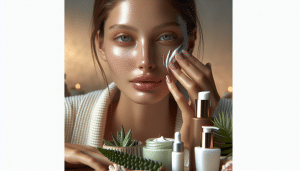You Might Be Missing These Skin Barrier Secrets
Natalie Brooks September 26, 2025
Learn how everyday habits, skincare routines, and new research directly connect to your skin barrier health. This comprehensive guide covers what matters most for lasting radiance, discussing gentle cleansers, hydration essentials, and why microbiome balance is a focus in modern wellness.
Understanding Your Skin Barrier for Healthier Skin
The skin barrier is the body’s frontline defense against environmental challenges—from pollution to dehydration. Experts often describe this layer as your skin’s ‘invisible shield.’ When intact, it keeps moisture in and irritants out, yet even tiny changes in daily habits can influence its function. Many people are surprised by how stress, physical exfoliation, or harsh weather disrupt the delicate balance. Even well-intentioned routines may leave this barrier vulnerable, which is why paying close attention to hydration and gentleness is so important (Source: https://www.aad.org/public/everyday-care/skin-care-basics/care/skin-barrier).
Keeping the skin barrier healthy can make a difference in how skin looks and feels. When compromised, you might notice increased dryness, sensitivity, or visible redness, especially around the cheeks and forehead. These are common signals. If ignored, they can eventually lead to persistent issues like flaking or even outbreaks. Many modern moisturizers and serums focus on replenishing the barrier with ingredients such as ceramides and fatty acids, helping restore natural vibrancy over time. Knowing what your skin needs helps you choose routines that support, not strip away, its natural defenses.
Despite all the marketing noise, effective skin barrier care is less about trending ingredients and more about a balanced, consistent approach. Mild, fragrance-free cleansers and products formulated for sensitive skin lay the groundwork. Don’t overlook small actions: patting skin dry instead of rubbing, keeping showers short and warm rather than hot, and using barrier creams overnight all contribute to protective care. Proper barrier support isn’t limited to luxury products. It’s a matter of daily mindfulness and evidence-backed routines.
The Microbiome and Its Surprising Role in Radiant Skin
The skin’s microbiome is a complex mix of microorganisms—most of them beneficial and essential for healthy skin. Each person’s microbial community is slightly different, influenced by diet, hygiene, and even air quality. A strong microbiome helps the skin barrier defend against pathogens while maintaining moisture. Disturbances, like over-cleansing or frequent use of antibacterial products, can disrupt this balance. Recent studies show that microbiome-friendly routines support skin that is less prone to inflammation, breakouts, and itching (Source: https://www.ncbi.nlm.nih.gov/pmc/articles/PMC6048199/).
Prebiotics, probiotics, and postbiotic skincare formulas are emerging as powerful allies for microbiome balance. These products encourage beneficial bacteria to thrive, strengthening the skin’s natural defenses. Some users report less reactivity and improved hydration over weeks of regular use. The key takeaway: not all bacteria are bad! Allowing your skin’s ecosystem to flourish can be part of a holistic wellness approach, working alongside diet and gentle hygiene. Many leading dermatology centers now offer guidance on microbiome-supportive regimens as a component of overall skin health.
It’s easy to overlook everyday factors, like dehydration, lack of sleep, or environmental changes, but these also stress the skin’s resident microbes. For example, rapid temperature fluctuations can degrade microbial communities. A well-moisturized face provides a friendlier environment for these microorganisms, while harsh treatments or extreme exfoliation may disrupt balance. Being mindful reduces risk and helps foster lasting radiance. Supporting the microbiome is about creating an environment where skin can bring out its healthiest glow.
Gentle Cleansing as Foundation for a Stronger Barrier
Cleansing is foundational—but aggressive facial washes can do more harm than good. A healthy skin barrier thrives on mild, sulfate-free cleansers that remove impurities without stripping away natural oils. Dermatologists recommend washing with lukewarm water and opting for creamy, low-foaming products. The goal is to leave skin feeling soft and comfortable, never tight or dry. Many people benefit from cleansing once daily at night to lift the environmental debris accumulated over the course of the day (Source: https://www.health.harvard.edu/staying-healthy/how-to-care-for-your-skin).
Over-cleansing, especially with exfoliating scrubs or acidic solutions, can weaken the barrier and lead to irritation. Gentle double cleansing—using an oil-based cleanser followed by a water-based one—can be helpful for removing makeup. For most skin types, mornings may require only a splash of water or micellar solution rather than a full wash. This ensures that skin’s protective lipids remain intact. Tweaking your cleansing approach even slightly often yields surprising improvements in moisture retention and softness.
Those with sensitive or mature skin may notice even greater benefits from reduced cleansing routines. Choosing fragrance-free and hypoallergenic cleansers can prevent reactions in vulnerable skin. Always blot—never rub—when drying your face, as friction from towels can damage delicate facial tissue. Real gains in skin comfort are often linked to these small, incremental changes. In the end, gentle cleansing habits make for a more resilient skin barrier and brighter complexion—proven steps that support a radiant, natural look.
Smart Hydration: The Moisture Barrier Connection
Hydration doesn’t just happen at the surface. Water molecules bind to the skin’s natural moisturizing factors, creating a plump and elastic appearance. Regular application of hydrating serums or lightweight creams, particularly those containing humectants like glycerin and hyaluronic acid, fosters a strong moisture barrier. Contrary to popular belief, more frequent application is not always better; choosing the right product for your skin’s needs is far more effective than over-layering (Source: https://www.clevelandclinic.org/health/diseases/21594-how-to-protect-your-skin-barrier).
Dry climates, heaters, and air conditioning can all contribute to moisture loss—prompting many to reach for richer creams in winter months. Occlusive ingredients, like squalane or petrolatum, trap hydration and prevent evaporation. Meanwhile, lightweight gel creams are often ideal when temperatures warm up. Balancing water intake and topical application ensures long-term improvement in skin softness and resilience. This dual approach—internal and external hydration—results in visible, lasting enhancements, especially in the face’s most delicate areas.
Drinking enough water contributes to skin health, but topical support remains crucial. Hydration after cleansing locks in moisture, especially within minutes of towel-drying. For many, swapping drying toners for essence mists or serums brings a noticable improvement. Keeping skin hydrated helps strengthen the barrier’s resistance to irritation and pollution, reducing overall sensitivity. The science is clear: smart hydration is never optional; it’s a pillar of both wellness and an effective beauty routine.
Barrier Repair Ingredients You Need to Know About
Certain ingredients are fundamental when it comes to repairing or maintaining the skin barrier. Ceramides, cholesterol, and fatty acids naturally occur in healthy skin and are commonly used in barrier-repair creams. Dermatologists agree that replenishing these elements can restore flexibility and minimize symptoms of irritation or dryness. Look for products that mention ‘barrier repair’ on the label, as these tend to have studied blends proven to improve the skin’s resilience (Source: https://pubmed.ncbi.nlm.nih.gov/31209901/).
Niacinamide, a form of vitamin B3, stands out as a multi-tasker supporting the barrier by reducing inflammation and calming visible redness. Clinical research suggests that regular application improves skin texture, brightness, and overall function. Some moisturizers also feature panthenol (pro-vitamin B5) or allantoin for soothing benefits. Understanding labels and selecting well-formulated products—rather than chasing every new beauty trend—can make a world of difference in comfort and appearance.
It’s helpful to avoid harsh actives like high-percentage acids or retinoids if your barrier is compromised. Instead, focus on repair and gentle support. Emollients such as shea butter and mineral oils help reinforce the protective film on the skin’s surface, aiding recovery after episodes of dryness or over-exfoliation. Recovery is gradual, but sustained use of proven barrier-supporting ingredients can bring lasting results and renewed confidence in your skin’s natural strength.
Lifestyle Habits and Environmental Impact
Skin barrier health isn’t just about products. Sleep, nutrition, sun exposure, and daily stress can all play a role. Skimping on rest may slow the skin’s ability to renew and repair during the night. Meanwhile, a diet rich in healthy fats, antioxidants, and vitamins is associated with stronger, more adaptive skin. It’s not uncommon for dermatologists to recommend a holistic approach—addressing internal and external factors collectively for best results (Source: https://www.dermnetnz.org/topics/skin-barrier-function/).
Outdoor environments introduce challenges like UV rays and airborne particles. Consistent sunscreen application, even on overcast days, shields the skin barrier from damage and premature aging. Wearing protective clothing and avoiding peak sunlight hours adds another layer of defense. When combined with barrier-supportive care, these routines reduce the risk of long-term dryness and visible signs of wear on the skin. Lifestyle adjustments do not need to be extreme, but small cumulative changes lead to noticeable improvement.
Reducing stress is a practical—and often overlooked—aspect of barrier maintenance. Chronic stress may directly suppress the immune system, increasing susceptibility to flare-ups or slow healing. Calm routines, adaptive coping strategies such as meditation or mindful exercise, and time spent outdoors all contribute to resilient skin over time. Lifestyle adaptations complement product routines, creating a comprehensive foundation for wellness and sustained beauty.
References
1. American Academy of Dermatology Association. (n.d.). Skin care basics: How to care for your skin barrier. Retrieved from https://www.aad.org/public/everyday-care/skin-care-basics/care/skin-barrier
2. Sanford, J.A. & Gallo, R.L. (2013). Functions of the skin microbiota in health and disease. Retrieved from https://www.ncbi.nlm.nih.gov/pmc/articles/PMC6048199/
3. Harvard Health Publishing. (n.d.). How to care for your skin. Retrieved from https://www.health.harvard.edu/staying-healthy/how-to-care-for-your-skin
4. Cleveland Clinic. (n.d.). How to protect your skin barrier. Retrieved from https://www.clevelandclinic.org/health/diseases/21594-how-to-protect-your-skin-barrier
5. Elias, P. & Schmuth, M. (2019). Essential fatty acids, metabolism, and skin barrier function. Retrieved from https://pubmed.ncbi.nlm.nih.gov/31209901/
6. DermNet. (n.d.). Skin barrier function. Retrieved from https://www.dermnetnz.org/topics/skin-barrier-function/








